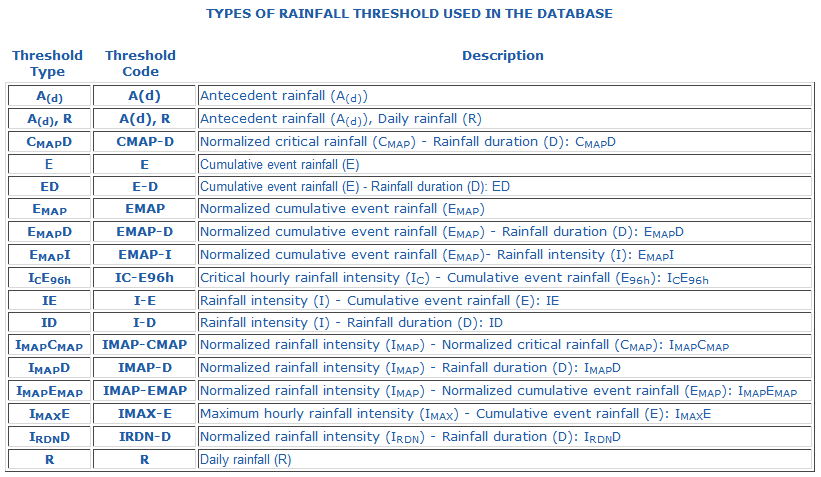

Empirical thresholds using combinations of precipitation measurements obtained from individual or multiple rainfall events that resulted (or did not result) in landslides can be subdivided in four sub-categories: (i) intensity – duration (ID) thresholds, (ii) thresholds based on the total event rainfall, (iii) rainfall event – duration (ED) thresholds, and (iv) rainfall event – intensity (EI) thresholds. Intensity-duration (ID) thresholds are the most common type of thresholds proposed in the literature. ID thresholds have the general form
where I is rainfall intensity, D is rainfall duration, and c ≥ 0, α > 0, and ß > 0 are parameters. To render comparable rainfall thresholds prepared for different areas or regions, investigators normalize the rainfall intensity values using empirical measures of the local climate (normalized intensity – duration (ID) thresholds). Most commonly, normalization is obtained dividing the event rainfall intensity by the mean annual precipitation (MAP) (e.g., Cannon, 1988; Ceriani et al., 1992; Paronuzzi et al., 1998; Aleotti et al., 2002; Bacchini and Zannoni, 2003). To normalize rainfall intensity, Wilson (1997) and Wilson and Jayko (1997) used the rainy-day normal (RDN), a climatic index that provides a better description (or proxy) than the MAP for the occurrence of extreme storm events most likely to trigger slope failures. Barbero et al. (2004) used the ratio between the MAP of two different areas to export an ID threshold defined for the first area and to apply it to the second area. A few authors have attempted to establish thresholds for the initiation of landslides based on the total amount of precipitation during the landslide triggering event (thresholds based on measurements of the event precipitation). Some of these thresholds are defined as percentages of the MAP. According to these thresholds, if the total precipitation during a rainfall event exceeds an established percentage of the MAP, landslides are likely to occur, or to occur abundantly. As an example, Guidicini and Iwasa (1977), working in Brazil, determined that when the total event rainfall exceeded 12% of the MAP landslides were likely to occur independently of the antecedent conditions, whereas when the total event rainfall ranged from 8% to 12% of the MAP landslides initiation was dependant on rainfall history. Similarly, Govi and Sorzana (1980), working in the Piedmont region of NW Italy, determined a relationship between the proportion of the MAP falling during a rainfall event and the abundance of the triggered landslides, and discovered that areas characterized by large MAP required a larger amount of rainfall to trigger slope failures than areas characterized by low MAP. Other investigators have related the duration of the rainfall event to measures of the event precipitation, including the cumulative event rainfall, the critical rainfall, and the corresponding normalized variables (rainfall event – duration (ED) thresholds). Still other investigators have linked measures of the event rainfall to the rainfall intensity, obtaining event – intensity (EI) thresholds. Onodera et al. (1974), who were probably the first to propose quantitative rainfall thresholds for the initiation of landslides, further proposed a set of thresholds linking the hourly event intensity to the ratio between the average and the maximum rainfall intensity per hour. Govi and Sorzana (1980) adopted a slightly different approach and linked the average event rainfall during the final phase of the storm (i.e., the period when landslides occurred) to the critical event rainfall, normalized to the MAP. These authors found linear (in Cartesian coordinates) and complex relationships, depending on landslide abundance, on the season of the event, and on the antecedent rainfall conditions. The following table lists the different threshold types considered in the database. The table lists: (i) the threshold type, (ii) the code for the specific threshold, that can be used to select a specific threshold type from the selection menu, and (iii) a description of the rainfall threshold type. |
